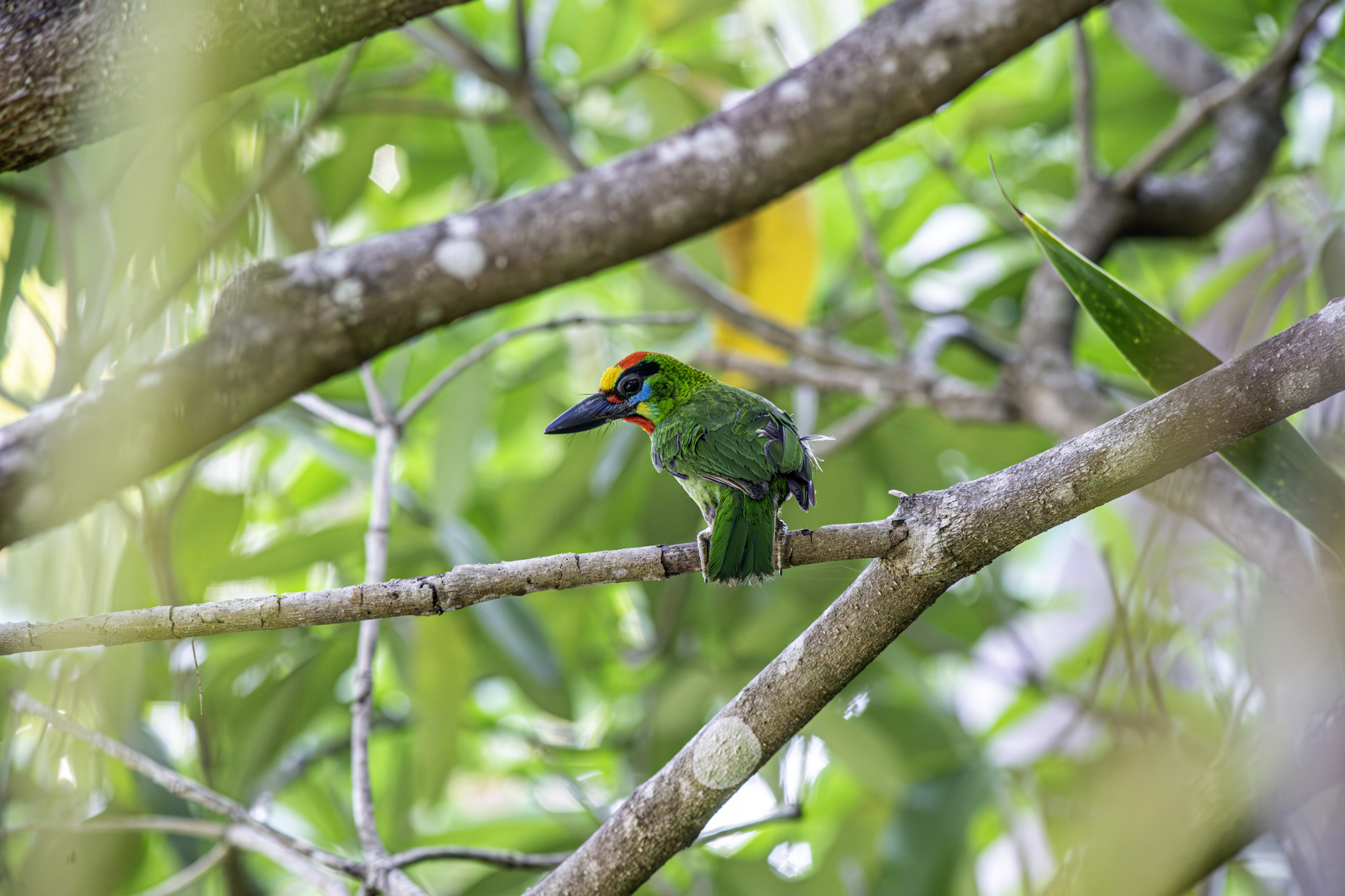Deep Overview: Red-Throated Barbet (Megalaima mystacophanos)
The Red-Throated Barbet (Megalaima mystacophanos), also known as the Black-Eared Barbet, is a colorful, fruit-eating bird found in tropical forests of Southeast Asia. It is part of the Asian barbet family (Megalaimidae) and is known for its bright plumage, loud calls, and strong beak, which it uses to excavate nesting holes in trees.
Taxonomy & Classification
- Kingdom: Animalia
- Phylum: Chordata
- Class: Aves
- Order: Piciformes
- Family: Megalaimidae (Asian Barbets)
- Genus: Megalaima (sometimes placed in Psilopogon)
- Species: Megalaima mystacophanos
- Common Names:
- Red-Throated Barbet
- Black-Eared Barbet
Physical Description
- Size:
- Length: 19–22 cm (7.5–8.7 in)
- Weight: 55–75 g (1.9–2.6 oz)
- Coloration & Markings:
- Bright green body
- Red throat and forehead
- Black markings around the eyes (“black-eared” appearance)
- Blue and yellow streaks on the face
- Large, thick beak (used for fruit consumption and nest excavation)
- Distinct Features:
- Zygodactyl feet (two toes pointing forward, two pointing backward) for gripping branches
- Short tail and compact body
Distribution & Habitat
- Geographic Range:
- Found in Southeast Asia, including Malaysia, Thailand, Indonesia (Sumatra, Borneo, Java), Myanmar, and southern Thailand
- Preferred Habitat:
- Lowland tropical rainforests
- Mangroves, secondary forests, and plantations
- Prefers dense foliage and is often seen at mid to high levels of trees
Behavior & Adaptations
- Diurnal (Active During the Day):
- Spends most of its time foraging in trees
- Solitary or Small Groups:
- Usually found alone, in pairs, or small family groups
- Strong Beak for Excavation:
- Uses its powerful beak to dig holes in tree trunks for nesting
- Loud Vocalizations:
- Produces repetitive, loud calls, often heard before the bird is seen
Diet & Feeding Habits
- Primarily Frugivorous (Fruit-Eating):
- Main diet: Figs, berries, and other tropical fruits
- Plays an important role in seed dispersal
- Occasionally Insectivorous:
- Eats insects, caterpillars, and small invertebrates (especially when feeding chicks)
- Feeding Strategy:
- Uses its strong beak to crush fruit
- Often seen hanging upside down to reach food
Reproduction & Life Cycle
- Breeding Season:
- March to August (varies by region)
- Nesting Habits:
- Excavates nest cavities in dead or softwood trees
- Both male and female participate in nest-building
- Eggs & Incubation:
- Lays 2–4 eggs per clutch
- Incubation lasts about 13–15 days
- Fledging:
- Chicks leave the nest after 30–40 days
Predators & Threats
- Natural Predators:
- Snakes, monitor lizards, birds of prey
- Mammals like civets and squirrels may raid nests
- Human-Related Threats:
- Deforestation and habitat loss (main threat)
- Illegal pet trade (though not as common)
- Conservation Status:
- Listed as “Near Threatened” (NT) by the IUCN due to rapid habitat loss
- Populations declining in areas with heavy deforestation
Ecological Importance
- Seed Disperser:
- Helps regenerate forests by spreading fig and fruit seeds
- Indicator of Forest Health:
- A declining population often signals forest degradation
Relationship with Humans
- Difficult to Spot Due to Dense Foliage Habitat
- Sometimes Kept in Captivity, but Not Common as Pets
- Threatened by Logging & Agriculture Expansion
Fun Facts
- Has a unique, rattling call that can be heard over long distances
- Can hang upside down like parrots while eating fruit
- Related to woodpeckers, but does not drum on trees
- Can live up to 10–15 years in the wild
Conclusion
The Megalaima mystacophanos is a vibrant, fruit-loving bird with a crucial role in forest ecology. Despite its small size, its loud calls, colorful plumage, and seed-dispersing behavior make it a significant species in tropical ecosystems. However, deforestation poses a serious threat to its population. Conservation efforts are needed to preserve its rainforest habitat.
Visited 30 times, 1 visit(s) today
Views: 448
Subscribe to the newsletter:
